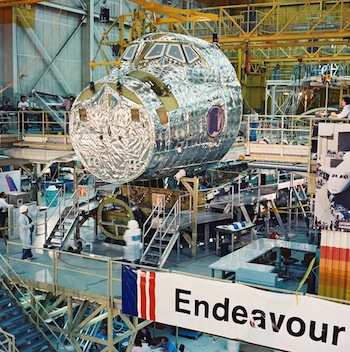OV-105, as Space Shuttle Endeavour is designated by NASA, is due to fly into space for the final time . Here's everything you need to know about this remarkable machine, which was put together from spare parts.
Her Name
Endeavour isn't the American English spelling of the word for a concerted, earnest attempt to reach a lofty goal--because OV-105 isn't named for the word. Instead she's named in honor of HMS Endeavour, the British ship which took James Cook on his first voyage of discovery in 1768. The main objective of the voyage, tasked by the Admiralty and the Royal Society, was to travel to Tahiti to accurately observe a transit of Venus across the Sun--a measurement that gave scientists an incredibly accurate measurement of the distance between the Sun and the Earth.
Endeavour was actually named as part of a competition among school kids in the U.S., and her name was popularly suggested, accounting for almost a third of state-level entries.
 The Spare Part Space Shuttle
The Spare Part Space ShuttleEndeavour, the newest shuttle, wasn't a planned addition to the fleet. Her existence is due to the Challenger tragedy, which changed NASA forever but left a gaping hole in its space launch capabilities--vital for the construction of the International Space Station.
Hence the contract to build Endeavour was awarded in July 1987, and she was put together largely from spare parts that had been constructed as part of the manufacturing process of Discovery and Atlantis, pieces of body that had been built at the same time as these vehicles (to minimize cost exposures) in case of any mishap. It took just five years to construct and test the vehicle, and she flew for the first time on May 7th, 1992.
Her Tech Specs
Endeavour is 122.1 feet long, with a wingspan of 78 feet and empty of fuel and payload she weighs 162,000 pounds (in comparison a 737-400 aircraft, typically used for long-range intracontinental flights, is 119.5 feet long, with a 94.8 feet wingspan and an empty weight of 73,000 pounds).
She's powered with three Rocketdyne Block 2A Space Shuttle Main Engines, each of which weighs over 7,000 pounds and is capable of pushing with 400,000 pounds of thrust (the engine of a 737 typically pushes at around 20,000 pounds at take-off). When lit, the engines burn at over 3,000 Celcius, and if their fuel pumps were used to pump water instead of fuel, each could drain a typical swimming pool in 75 seconds.
Endeavour's cargo bay is 15 feet wide by 59 feet long, and she can lift up to 55,250 pounds of cargo into orbit.
Endeavour's Advanced Tech, Ahead of the Rest
Because she was built last, the companies responsible for constructing Endeavour could include more advanced technology.
This included a 40-foot drag chute for landing, halving the rollout distance, better avionics, better nose wheel steering, better auxiliary power units to drive her hydraulics, an external airlock enabling docking to the ISS, stronger wings and a lighter-weight construction. These advances were later included in re-fits of the rest of the fleet.
 The Hubble Space Telescope Mission
The Hubble Space Telescope MissionPerhaps Endeavour's finest moment was the very first mission to service the Hubble Space Telescope--a vital mission to repair a manufacturing flaw that seriously limited the telescope's usefulness. Launching December 2 1993, the shuttle flew up to the HST's high orbit at 321 nautical miles in what was the most complex, and one of the riskiest shuttle flights undertaken to date, with a 1 in 150 calculated chance of catastrophic failure due to collision with space debris or micrometeorites.
Five spacewalks were needed to repair the telescope's various systems, which was a record at the time. The repairs were a complete success, and transformed Hubble into one of the most remarkable tools for astronomy ever made.
Today's Unique Payloads
Flying in the shuttle today are a couple of unique pieces of hardware.
The first is the AMS2, the second Alpha Magnetic Spectrometer, based off a flight of an earlier prototype, which is a billion-dollar experiment to detect such neat things as antimatter, dark matter and strangelets (a physics oddity: particles made entirely of strange quarks). It's all about hard science to solve some big puzzles, and will function on the outside of the ISS for up to 10 years.
The second unique payload is 13 Lego sets, flying as part of the Lego Bricks in Space program--a scientific and educational experiment which will see astronauts building various models and seeing how they react in microgravity. The results will be shared with schools when they begin in September.
Where She'll Rest Up
When she lands after the current mission, Endeavour will undergo a major dismantling program to render her safe to be displayed in a museum--in this case the California Science Center in Los Angeles, although the shuttle's Canadarm robot arm is being removed for display in an undecided location in Canada.

No comments:
Post a Comment